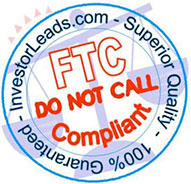Investment Sales Leads
Free lead special, Call today! 561-208-6060
Reach high income / high net worth
Equity investors
Free Lead Specials……561-208-6060
Quality leads….. Reasonably Priced
| 1,500 leads at 18¢ = $270.00 | 3,000 leads at 11¢ = $330.00 |
| 5,000 leads at 9.5¢ = $475.00 | 10,000 leads at 7¢ = $700.00 |
Have any questions……….
Give us a call!
561-208-6060
Affluent Investor leads that are new, fresh and qualified.
All of our investor leads are fresh, current and come with a 100% satisfaction guarantee for quality and accuracy.
Have questions? Want more info?
Call us now with no obligation! Tel. 561-208-6060
click here for a FREE QUOTE.
To place your ORDER ONLINE click here
FTC compliant:
All investor leads are FTC compliant and have been scrubbed against the national FTC do not call list.

exclusive:
We get new investor names in monthly and give a 180-day exclusive on each lead. We guarantee 100% that the leads are clean and “unhammered”.
pricing:
As a small company with low overhead, we are able to provide you with highly-qualified investors at very competitive prices. If you find a lower price, please let us know. We will beat any advertised price, just ask!
Residential Leads:
- 1,500 leads at 18¢ = $270.00
- 3,000 leads at 11¢ = $330.00
- 5,000 leads at 9.5¢ = $475.00
- 10,000 leads at 7¢ = $700.00
Business Leads:
- 1,500 leads at 18¢ = $270.00
- 3,000 leads at 11¢ = $330.00
- 5,000 leads at 9.5¢ = $475.00
- 10,000 leads at 7¢ = $700.00
Media Pricing:
$10 per disc for CD-Rom, 3,5″ floppy, Zip Disk 1 cent per lead for 3″ x 4″ cards $5 per 500 mailing labels (ie. 2000 leads = $20.00)
Any selects (like city, zip, scf, area codes, counties) add 3 cents per record.
Pricing example:
2000 leads in your county/zip code/area code would cost you 18+3=21 cents a piece, 2000 X 21 cents = $420.00
100% satisfaction guaranteed
Our leads are continuously cleaned and updated monthly in order to provide our clients with the cleanest, most accurate information possible on each investor. All of our investor leads are guaranteed to be 100% accurate. We will replace any record that is in error. 100% SATISFACTION GUARANTEED
format:
Below are some of the formats available. If you need something specific, contact us. We can provide any format needed. You can receive your leads within 1 hour via email. Typical file formats are Adobe Acrobat (12 or 24 records per page, .pdf), Microsoft Excel (.xls), ASCII comma delimited (.cvs or .txt). Click each underlined format to see a sample.
-
- e-mail (receive your leads within 1 hour)- No Charge
- 3.5″ diskette ($10 per disc)
- CD-ROM ($10 per disc)
- ZIP disk ($10 per disc)
- Electronic transfer (No Charge)
- 8 1/2″ x 11″ paper (either 12 or 24 records per page) – No Charge
- 3″ x 5″ cards (1 cent etra per lead)
- Mailing labels (peel and stick 30 per page AVERY 5160) – $5 per 500 labels
- contact us for any other format.
payment:
We accept the following payment methods.
Visa, Master Card, AMEX, Discover, Company Check, Money Order, Cashiers Check
delivery:
We can E-mail your leads to you immediately, receive your leads within 1 hour, no shipping charges (for special orders delivery time may vary).
For any printed material (3×4 Cards, Paper, Mailing Labels) overnight delivery available upon request: UPS, FedEx, DHL, USPS
Since 1987 we have been providing the financial industry (ie. stock brokers, financial advisors, private placement brokers, oil & gas and commodity brokers) fresh pre-qualifed leads at the absolute most competitive pricing. Check out the competition. Before ordering from them, do yourself and your company a favor, CALL US ! No one beats our knowledge of the industry, our service or our price. We guarantee it!
Have questions? Want more info?
Call us now with no obligation! Tel. 561-208-6060
click here for a FREE QUOTE.
To place your ORDER ONLINE click here

Investment Sales Leads Information
Billions of dollars from business-to-business marketing budgets are spent each year on sales lead generation. Billions more dollars are spent to fulfill and follow up on marketing responses, and to determine which sales leads are qualified and ready for sales attention. Unfortunately, much of this investment in sales lead generation is wasted. Why? Because many sales lead generation programs and lead qualification efforts are not in harmony with the needs of sales.
With this in mind, have you optimized your company’s sales lead generation programs to be in harmony with the needs of your salespeople, reps, resellers or distributors? Here are some questions to ask yourself:
- Have you built consensus with sales management on the definition of a qualified sales lead? Has this definition been clearly communicated to all parties?
Typical definitions include criteria such as:
Does the prospect have a need or an application for your product or service?
What is the prospect’s role in the decision-making process?
What is the prospect’s timing for purchase or implementation?
What is the status of the prospect’s budget?
What is the size of the opportunity?
2. Have you calculated how many qualified investment sales leads are needed in the sales pipeline in order to meet or exceed the company’s sales revenue goals? Have you broken that number down into how many qualified sales leads are needed each month and each quarter? Have you built your company’s sales lead generation programs with those target numbers in mind?
3. Have you put in place programs specifically designed to weed out the non-prospects and nurture the longer-term, not-yet-qualified opportunities-only forwarding the truly qualified sales leads to salespeople, reps, resellers or distributors for follow-up? Have you budgeted appropriately for this important sales lead development function?
If you answered “yes” to these questions, the good news is that you are not
guilty of wasting your company’s sales lead generation investments. Instead, you are probably well respected by the people in sales and corporate management.
How You Really Win Clients and Land Mega-Deals as an Investment Banker
Why does the mainstream media hate Wall Street so much?
You can think of dozens of reasons, but one of the biggest is that they don’t understand what bankers really do to earn their fees.
They see news of million-dollar bonuses and assume that financiers earn those bonuses by sitting around and playing Monopoly.
But you don’t earn massive fees by playing board games all day – it’s a process that takes years, which is one reason why bankers make the money they do.
And the infamous “pitch” has very little to do with it.
It’s All About the Pitch, Right?
The most common, wrong suggestion I’ve seen before is that “Bankers win clients by pitching them.”
But that’s like saying that you got into Harvard or Oxford by submitting a really good application – technically true, but not the full story.
Yes, the application is critical and if your essays suck, you’re screwed – but you got into a top school because you spent years developing the skills and experiences to do so, and you then presented them in the best possible light.
It’s the same with winning clients as a banker: your pitch needs to be on-point for you to win the deal, but the process of putting yourself in the position to pitch for the deal starts long before that.
What Really Happens
As you move up from Associate to VP and beyond, gradually you’re tasked with more and more sourcing work: finding potential clients, getting to know them, and then pitching for a deal when the time is right.
Managing Directors spend almost no time on deal execution – unless it’s a massive transaction that requires their involvement – and instead spend most of their time on finding new clients and serving existing ones.
If you already work with a company on all their M&A deals and your bank has been advising them for the past 20 years, you’ll probably continue to do so in the future.
Like legacy admissions in university or Roger Sterling and Lucky Strike, it’s a good bet that you’ll receive the benefit of all that history unless you make a colossal screw-up.
So it’s more interesting to look at how you find new clients – companies your bank has never worked with before.
This entire process is more applicable to smaller firms than to bulge bracket banks, because there the “legacy” factor is high and you mostly work with huge companies that everyone already knows about.
But even at huge firms, you still need to find new clients because existing companies get acquired, merge, and go out of business all the time.
Lead Generation
In sales, a “lead” is just a potential customer – someone who might sign up for the products or services you’re offering.
It’s the same idea in banking, but since your leads are fewer in number and are worth much more, some strategies don’t work so well.
What Doesn’t Work
Strategies like online marketing (paying for ads on websites, Google, Facebook, etc.), TV/radio/direct mail advertising, and posting flyers would never work.
It may sound silly to even point this out, but I’ve actually seen some banks use Google AdWords to market themselves to clients and I have no idea why they bother.
All these methods are too impersonal – it’s like walking into Armani and having a robot display a list of recommended clothes for you rather than having a real live person greet you, chat for a while, find out what you’re looking for, and then suggest something good.
When the number of clients is low and the per-client value is high, you need to get very personal to make deals happen.
PE / VC / HF Referrals
One way to do this is to go through your friends on the buy-side, see what portfolio companies they have, what sectors they’re interested in, and who else they’ve been speaking with lately.
Let’s say you’re an MD who has worked with a private equity firm for 10+ years. At your next catch-up meeting with them, you might casually ask how their portfolio companies are doing (translation: are any of these companies ready to sell, refinance debt, or go public?).
If the PE Partner likes you and wants to give you business, he might refer you to the CEO or CFO and say, “Hey portfolio company, this banker’s good – you should get to know him.”
Or if a deal is imminent, he might tell you directly: “They’re going public next year, and the pitch is coming up next month – we’ll be sure to include you.”
In tech and healthcare groups, venture capitalists are arguably more important and bankers get referrals to startups via VCs.
Cold-Calling/Emailing
Just like with your own networking efforts, cold-calling is less effective than meeting in-person first or getting referrals – but sometimes it works.
You’re far more likely to see cold-calling at smaller banks where you have to fight for every deal – and if you’re a summer analyst there you might get tasked with poring through lists of companies and finding contact information.
Cold-calling is also more common at small and middle-market private equity firms, some of which are notorious for making their newly hired associates cold-call companies all day long.
Conferences
Bankers also spend a lot of time on the conference circuit, meeting with executives at events (CES, Davos, etc.).
These are like information sessions: if you can stand out from everyone else and then follow-up appropriately, your chances of success go way up.
The real action at conferences happens offstage, so bankers skip keynotes and panels and schedule as many 1-on-1 meetings as possible during the day.
Inbound
Wouldn’t it be nice if banks just called you when they wanted to hire someone?
When companies want to sell or raise capital, they sometimes contact banks directly – this scenario is much more likely when a lesser-known company wants to work with a bulge bracket bank and has no other way to get on their radar.
Sometimes investors also contact bankers directly and provide the introduction, especially if they’re pressuring the company to sell so they can realize their returns.
Wining & Dining: Building the Relationship
Once you’ve contacted or been contacted by the executives at this potential client, you need to build the relationship.
If it’s an inbound contact and they urgently need to sell or raise capital, you won’t do this and you may be asked to pitch for the business right away.
But if the deal is further off in the future, you need to take time to build trust and convince the CEO that you’re not just another Gordon Gekko or Patrick Bateman character waiting in the shadows to decapitate him and steal all his money.
You do that by:
- Coming up with acquisition ideas and meeting with the executives to discuss what areas they might want to expand into.
- Giving market updates to the executives and telling them what’s going on in the M&A or capital markets.
- Meeting casually for lunch or dinner to catch up on what the company has been doing and their future plans.
- Being “on call” to answer whatever questions they have, whenever they have them.
The tricky part is that you don’t get paid for any of this – and the entire process could take years before you see any revenue.
Sure, making $10 million on a single deal sounds great – but if it takes 10 years of relationship building to get there, the NPV is much lower than $10 million.
This is the slowest and most extended part of the “client-winning” process, and if you’re not interested in relationships, this is where you’ll fail.
But if you like meeting and greeting and can’t stand Excel, then you might make a great MD – even if you’re a lousy analyst.
Deal Time
How does a company decide when it should sell, buy another company, go public, or raise capital?
Sometimes it’s forced to sell by investors who want to realize their returns (Amazon / Zappos) – going back to our theme of NPV, the longer an investment stays unrealized, the harder it is to get solid returns.
Other times the executives reach the decision themselves – the CFO looks at their cash flow projections and realizes their burn rate is too high, so they decide to raise debt or equity.
And still other times, bankers “plant” the idea in the CEO’s mind.
While you don’t have to plant this idea in a dream within a dream within a dream within a dream, you do have to be subtle about it – going out and blatantly pitching an LBO won’t work even if you really want a PE firm to buy the company you’re speaking with.
Instead, bankers are more likely to make casual references to private equity firms and leveraged buyouts elsewhere in the market when they meet with the company to discuss other topics.
Over time, if the CEO and Board buy into the idea or show interest, the bankers keep selling them on it and gradually start to reveal more and more information.
The best bankers – the true rain-makers – are the ones who are best at “selling” the company on a transaction, even if the management team had no interest initially.
Regardless of whether the idea was planted or original, once the company decides it’s ready to sell or raise capital, it then pits bankers against each other in a bake-off.
The Pitch
Sometimes if a company has a special relationship with just 1 banker and has never spoken to others, it will skip the pitch and give the business to that banker.
But that’s more common at private and smaller companies where there’s not as much oversight from the Board of Directors – at anything bigger the Board usually requires the management team to solicit competitive offers.
At this point they would contact all the bankers they’ve gotten to know over the years and tell them what they’re planning, send over relevant financial information, and invite them to pitch for the deal.
The number of banks invited depends on the deal type – IPOs have many banks, whereas in M&A deals there’s just 1 or 2 advising the buyer and seller – and whether or not the company wants to stick with the bankers it knows best or go for a broader set.
Who Wins the Deal?
This must come down to whether or not you’ve dotted all the i’s and crossed all the t’s in your pitch book, right? And whether or not you remembered to change the font size on every single page, right?
Nope – most of the time the pitch book itself is irrelevant to winning the deal, even if you pulled 4 all-nighters to create it.
What matters is how much the company likes the senior bankers, what the senior bankers say, and how they say it – and what they say compared to the other bankers pitching for the deal.
Let’s say you go in and claim that the company is worth $500 million and that you can complete the sale process in 6 months. Then another banker goes in and says the company is worth $400 million and that the sale process will take 12 months.
You might assume that you’ll win since your claims are more aggressive and will result in a better price for investors – and sometimes that’s true.
But the CEO and other Board members/executives could also look at your pitch and think that your numbers are unrealistic and that you’re not being honest – especially if everyone else there is predicting lower valuations.
So you need to use a careful blend of salesmanship and pragmatism to win deals.
After the Pitch
There may be a clear “winner,” but more often than not, the company will follow up with multiple banks to see what the fee structures are like and what their recommendations are in more detail.
For smaller companies and deals, the fees make a bigger difference and sometimes a bank will win the deal by promising lower fees or a structure that rewards them for better results (e.g. 0.75% under $500 million and 1.5% for the amount above $500 million).
Most of the time, though, it comes down to all of the above factors and the company considers everything when making a decision.
This is not a rational or logical process – just like selecting which applicants will receive interviews, it’s random and fraught with emotion.
If you think executives are rational just because hundreds of millions or billions of dollars are involved, nothing could be further from the truth – sometimes the more money that’s involved, the less rational the deal (AOL / Time Warner).
Sample Timeline
Putting everything together, here’s an example of how you, after you become a Managing Director, might meet a CEO, develop the relationship, and then pitch for the deal:
5 years ago you were having a catch-up meeting with a local VC and he mentioned that a tech startup in their portfolio was hot and would change the world of online media.
He gave you an introduction, so you met with the CEO, learned about his vision for the business, and got an idea of the company’s financial performance.
A year later, you caught up with the CEO once again and gave him an update on the capital markets and what IPOs were pricing at. The company was not yet cash flow-positive, but they had killer revenue growth.
The next year (3 years ago), the IPO markets were closed but the CEO wanted to use his stock to acquire smaller competitors – so you ran a buy-side M&A process for him over the course of 6 months. It never went anywhere since they couldn’t find anything good and got distracted by other issues.
Then, 2 years ago, the company finally turned cash flow-positive and started thinking about an IPO, which they told you about during your quarterly meeting with them.
You made your analyst monkey stay awake for 60 hours straight to prepare a 200-page pitch book laying out all the nuances, but then the CEO decided to hold off until the market got better.
Finally, a few weeks ago the CEO contacted you again just before another meeting and said that they are now serious about selling and want to hear your thoughts – so he invited you in to pitch for the deal.
Got Risk?
Not only did this process take 5 years, but there’s no guarantee that this planned sell-side M&A deal will even happen – or that the mandate will go to your bank.
Maybe no one will be interested; maybe the CEO will change his mind yet again; or maybe investors will pressure them to go public instead.
And you ran a failed buy-side M&A process for them a few years ago.
This is why investment banking is such a tough business: you could do everything right for 5 years and still lose the deal because your fees are 0.1% too expensive, or because the CEO gets emotional and happens to like an unknown banker more.
Wait, This Sounds Boring!
One time I was explaining this process to a friend who was still in university and he said, “Wow that sounds boring – I’d rather do modeling and analytical work.”
If your IQ is higher than your EQ, it may not sound too appealing to develop relationships like this and constantly pitch for new business.
But as Jonathan Knee points out in The Accidental Investment Banker (highly recommended), all deals start to look the same after a while.
You learn a lot at first and valuing and modeling companies seems exciting when you’re new, but they become routine and boring once you’ve done them 500 times.
We’re more interested in stories and inter-personal drama than we are in staring at Excel all day – so even if the process above doesn’t sound interesting right now, you may change your mind in a few years.
You might assume that you should move to the buy-side if you’re not interested in any of this, but that’s only partially true – in PE and VC you still do a lot of relationship-building, meeting with new companies, and so on.
So if it’s really not your cup of tea, think about hedge funds or trading – where you can make bank without talking to people or leaving your 8 computer screens.
Lead Categories
Click Below for a free quote
or to place an order online



